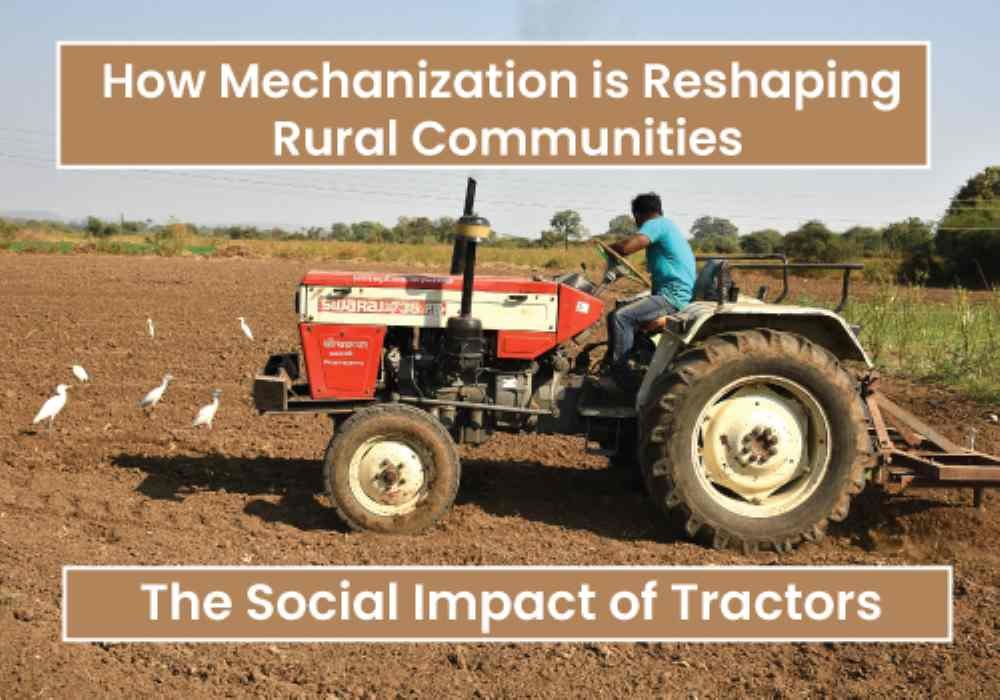No longer simply a utilitarian instrument for agriculture, the tractor has emerged in wide geographies of distant rural communities as an iconographic expression of change. During the past century, tractors have transformed farming practices by helping farmers to produce more with less labor. Apart from this technical dimension, the advent of tractors has also had significant social consequences by almost changing the entire countryside. As the machines have developed, so has their wider role in mechanized agriculture out of the field and into social, economic, and cultural aspects of rural life.
1.Tractor and Crop Productivity
And the core engine driving up its social impact is how it increases farm productivity. In traditional farming, most of the rural community depended on hand tools like Hoe, Chisel, and other manual equipmentAnimal drawn plows etc. With these ancient ways, however attractive and romantic they may sound to the modern green-eco ear, the yield was low; because of it rarely could a territory be conquered or become an economically flourishing region.
So the game was afoot and then along came tractors in rural life. Thanks to tractors, farmers can cover more land in less time, which increases yields and ultimately food supply. However, there are additional benefits from this increase in productivity as it tends to spill over into surrounding rural communities and ensures more consistent food supplies while channeling economic growth back toward the locals. Farmers can now sell their surplus crops as a result of better yields, which augments their livelihoods and quality of life.
Tractors empower both communities (as agriculture is often one of the biggest sources of economic mobility) and entire countries. The resulting cycle means more people can afford to send their children to school, access health care, and engage in non-agricultural activities. This leads to integrated economies with efficient transportation networks and safe drinking water—needs ever-present for developing nations.
In a country like India, where nearly half the population relies on agriculture, tractors have enabled farmers to move beyond subsistence farming into commercial agriculture. This shift brings greater economic stability to regions long affected by poor agricultural yields, allowing for both financial improvement and access to technology. Generations of economic stagnation are finally starting to trend upward, providing farmers with better days and much-deserved upgrades.
2.Implying Lower Labor Needs Are Good Or: The Social Ramifications Of It
The introduction of tractors caused significant transformations in the nature of labor inside that part of a regular rural community. For much of history, agriculture was a communal activity that required the collaboration of entire families and even communities to plant, grow, and harvest crops. The use of tractors, however, has led to a huge drop in demand for human labor on the farm leading to job shifts within rural areas.
A positive to draw from it is the fact that farming, which once was so hard and backbreaking for the laborers who spent hours working long days on a farm field, decreases some of this physical burden, giving them more time and energy for better pastimes. Younger people are seeking education and careers outside of agriculture. This shift is transforming rural economies, with more individuals now employed in fields like education, health care, and technology—areas that were once out of reach
But this shift has also brought certain obstacles. Rural workers who have their jobs displaced as farming becomes less labor-intensive in the future. People’s whole lives in such work are difficult to re-employ as farms “mechanize” even more. As a result, in certain parts of the country, displaced workers have been going to cities looking for work between urban centers and rural peripheries.
While there have been some downsides, the net social effect of mechanization seems to be strongly positive. Some new opportunities include agribusiness and the maintenance of farm equipment, while others are in various forms of agro-processing. Tractors not only reduced the physical labour on agriculture but also paved way for economic growth and development in rural Development.
3.Health, Way of life, and sustainability.
Tractors have improved in efficiency but also brought about ecological problems. Tractors serve as essential transportation tools, but over time, they also compact soil, emit more carbon, and increase chemical inputs. However, these issues are becoming a thing of the past as newer, more sustainable tractor technologies are now being implemented on farms
Electric tractors, precision farming technologies, and headed robots are being developed to reduce the environmental impacts of mechanized agriculture. Allowing farmers to conserve resources and reduce consumption while maximizing productivity a reducing carbon footprint!* When rural communities embrace these agricultural technologies, they do so not only to hack productivity into higher numbers but also by helping them contribute better and more sustainable farming practices for the environment.
Conclusion
The social by-products of tractors transcend the mechanical specificities in farming. Tractors have revolutionized rural areas ensuring higher productivity, lesser requirements of labor and paving way for more economic growth. They have been symbols of social mobility, female empowerment, and farmer cooperation. More tractors are redefining the social, economic, and cultural life-world of rural areas as they descend upon those places.
As problematic as they are especially in the ways that communities can get access to mechanization, and some land management is unsustainable because of tractors (though footprint per tonne moved appears significantly lower) there’s no getting around it: In general terms, I think we’ve got a net positive impact! While the rural societies of our planet shall further standardize for mechanization, tractors will be in first-line during this ongoing transformation path by crossing limits to make millions gain a better life.

